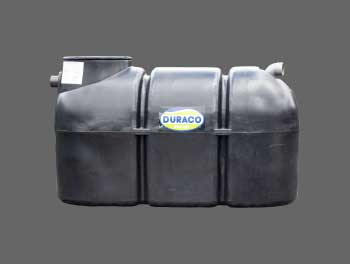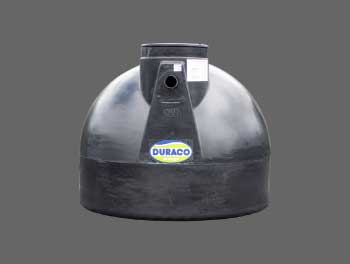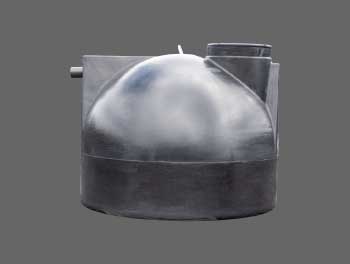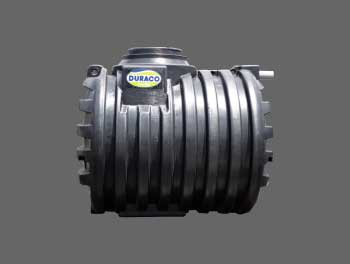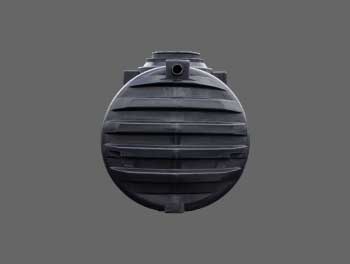SIZING OF SEPTIC TANKS
Average Waste-water generation per person – 180 Litres/day
Retention Time for Treatment and Reaction – 48 hours (2 days)
Volume Required for Treatment = Volume of Waste-water Generated.
Volume of Waste-water generated in 48 hours = No. of Person x Wastewater Generated Per Person x 2
For example: A family of 5 persons will require a 1,800 L Septic Tank (5 x 180 Lt x 2)
Waste-water (black water from Toilet) enters the septic tank through a 110mm diameter pipe on which a venting pipe (Air Vent) should be connected. For each flush, waste-water flows down through the pipe picking up oxygen through the air vent pipe.
As waste-water enters the septic tank, it is segregated in three segments:
Segment A – Upper part of the septic tank consists of Fats, Oil and Grease (FOGs). In this zone, aerobic bacteria gradually degrade the FOGs.
Segment B – Middle part of the Septic tank is the Aerobic zone consisting of suspended matter, oxygen and aerobic bacteria. In this segment, the organic matter is degraded to form Carbon dioxide and Water. Carbon dioxide diffuse out through the Air vent.
Segment C – Anaerobic zone consist of sludge (mixed of settled solid degradable organic matter and dead cells of bacteria) and anaerobic bacteria. In the anaerobic process, carbon dioxide, hydrogen sulphide, methane and water are formed. These gasses get diffused out through the air vent pipe. The treated water passes through the pre-filter basket into the absorption pit.
INSTALLATION PROCESS
Step 1: Excavation: –
Dig to a depth that will provide a maximum of 300 mm of fine soil over the top of the Septic tank.
Allow 230 mm around the tank.
Step 2: Bedding: –
Allow for a minimum of 150 mm of compacted bedding material rock sand. Bed the rock sand and make sure the surface is levelled. Placed the septic tank on the levelled bed.
The septic tank is supplied with PVC sleeves [internal diameter 110 mm] at the inlet and outlet. The inlet and outlet pipes should be glued to the sleeves using standard PVC glue.
Step 3: Backfilling: –
Ensure the tank lid is properly screwed on the tank manhole. Fill the tank with water through the inlet as you backfill, keeping the water level even with the backfill level. This will prevent possible distortion of the tank and its manhole. Do not remove the lid until the end of the backfill process.
Backfill in layers of 200 mm at a time and properly compact each layer. Ensure to compact each end first. Compact the backfill under the inlet and outlet before fixing the pipes.
Maximum backfill over the top is 300 mm. Mound fine soil over the top to provide positive drainage
NOTE: In case the septic tank needs to be installed with more than 300mm of soil above its top, it must be protected by a heavy-duty concrete slab. THE SLAB MUST REST ON FIRM SOIL AROUND THE TANK
Step 4: Septic Extension: –
In case the manhole screwed lid does not reach the ground level, a septic extension will be required. Install the extension to the manhole outlet before starting the backfill process. Make use of Duraco septic extension EXCLUSIVELY. The screwed lid supplied with septic will fit the septic extension.
Step 5: Leaching Field or Drain Field Material: –
The home sewer drain needs to slope at least ¼ inch per foot downhill to the inlet of the septic and the outlet pipe must cater for a downhill slope of 1/8 inch per foot to the absorption pit. The absorption pit should be at a distance of not more than 3 m from the septic and its volume must be at least similar to that of the septic tank.
- To keep a septic tank functioning properly, it is advisable to have the septic tanks pumped every five years.
- lf the septic tank has not been utilised for a long period, it is advisable to flush toilets several times to re-activate the aerobic process of the septic tank.
Caution:
Failure to comply with the points below voids the warranty
- Do not install any tank in water saturated clay or in high water table. The tank may collapse and its content will escape.
- Tanks are not fire-resistant. Do not store them near an open flame or heat in excess of 180°F,
- Do not install any tank under the path of vehicles or heavy equipment unless protected by a heavy-duty concrete slab, without resting on the septic tank.
- When the septic tank is pumped for normal maintenance; it should be refilled immediately.
- Our septic tanks are designed for underground use only.
- Protect the tank from sharp objects which could cause leakage.
- Avoid abusive use of detergent
What base is required to install a septic tank?
For our septic tank NO concrete base is required. The tank just has to be placed on a 150 mm rock sand bedding.
Do you provide warranty on your septic tanks?
3 years Warranty
Can I install a septic tank under a driveway?
No, installing the septic tank under a driveway is not permitted and will void the warranty.
In case it is located under the driveway, or in the pathway of heavy vehicles, the tank MUST be protected by a reinforced concrete slab that rest on firm ground. The septic tank should NOT support the load of the concrete slab. A riser will then be adapted at the septic tank manhole to reach ground level.
Can I build over my septic tank?
It is not recommended to build over the septic tank. Access to the tank is necessary for inspection and maintenance. Anything built over the tank would have to be removed for pumping and repairs.
What are the advantages of Duraco Septic Tank compare to concrete septic tank?
- Concrete can Crack Over Time
- Higher Risk of Contamination
- More Expensive
- Involves Complicated Installation
How long does the septic tank last?
Septic systems are designed to provide long-term, effective treatment of household waste when operated and maintained properly. However, most systems that fail prematurely are due to improper maintenance.
What should and should not go into my septic tank?
The best situation for a septic tank would be that only human wastewater enters the tank. This includes proper toilet tissue.
Can a septic system be repaired?
Yes. Depending upon the problem, a repair is possible.
What is considered a proper maintenance of my septic system?
Maintaining your septic system requires regularly pump outs and satisfactory bacteria presence to aid in the digestion of organic solids. Neglecting proper maintenance will result in system distress and ultimately, system failure.
How often should my septic system be pumped out?
It is recommended to have the system pumped out every 3 to 5 years depending on the size of your household
What is an aerobic wastewater treatment unit?
An aerobic system allows for biological (oxygenated aerobic bacteria) to decompose organic waste. This method differs from the traditional septic tank which uses anerobic bacteria to breakdown the organic waste. The introduction of oxygen is then done through either a biological solution using bacteria and enzymes or with a mechanical system that pumps air in and agitates the mixture.
What is the difference between aerobic and anerobic?
There are two types of bacteria. One is anerobic which is the type found in a traditional septic tank. The bacteria break down the solid waste in this closed environment of the tank without oxygen. The second type of bacteria is aerobic which uses oxygen to break down the solid waste.
Is the aerobic system better than a traditional septic tank?
The aerobic system breaks down the waste water materials much better than the traditional septic tank. The resulting effluent water discharge is far cleaner and better and safer for the environment.
What is the aerobic advantage?
Basically the aerobic method of treating household wastewater is that it breaks down a higher percentage of solids before discharge into the leach field or environment. A second advantage is that it breaks down the waste much faster than the traditional septic system.
